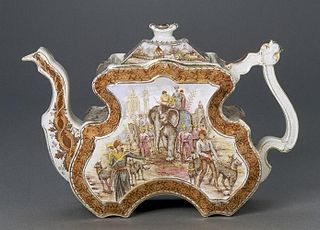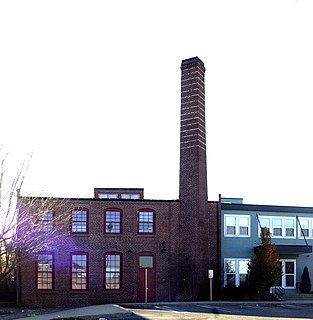
East Liverpool is a city in southern Columbiana County, Ohio, United States. The population was 9,958 at the 2020 census. It lies along the Ohio River within the Upper Ohio Valley and borders Pennsylvania to the east and West Virginia to the south. East Liverpool is included in the Salem, OH Micropolitan Statistical Area, about 40 miles (64 km) from both Youngstown and downtown Pittsburgh.

Lotus Ware is a type of porcelain produced from approximately 1892 to 1896 at the Knowles, Taylor & Knowles (KT&K) pottery of East Liverpool, Ohio, United States. It is thought that the name may have originated from a comment made by the owner, Isaac Knowles, asserting that the glaze of the pieces resembled the glossy sheen of lotus blossom petals. These ceramics were ranked at the top at the 1893 World's Fair in Chicago, where they won every prize for fine porcelain. It is generally considered to be the finest porcelain ever produced in the United States.

The Gladstone Pottery Museum is a working museum of a medium-sized coal-fired pottery, typical of those once common in the North Staffordshire area of England from the time of the industrial revolution in the 18th century to the mid 20th century. It is a grade II* listed building.

Burleigh Pottery is the name of a pottery manufacturer in Middleport, Stoke-on-Trent. The business specialises in traditionally shaped and patterned domestic earthenware of high quality.

Winchcombe Pottery, near Winchcombe in Tewkesbury Borough, North Gloucestershire, is an English craft pottery founded in 1926.

This is a list of the National Register of Historic Places listings in Columbiana County, Ohio.

Dorchester Pottery Works is a historic site at 101-105 Victory Road in Dorchester, Massachusetts, a neighborhood of Boston. The Dorchester Pottery Works was founded in 1895 by George Henderson and made stoneware. The Dorchester Pottery Works closed in 1979. The building was designated as a Boston Landmark in 1980 and added to the National Register of Historic Places in 1985.

The Museum of Ceramics, housed in the former East Liverpool Post Office, is a ceramics museum that contains an extensive collection of ceramic wares produced in and around East Liverpool, Ohio, United States. The museum is operated by a Museum of Ceramics Foundation and by the Ohio Historical Society in a city long known as "America's Crockery City" and "The Pottery Capital of the Nation."

A bottle kiln, or bottle oven, is a type of kiln. The word 'bottle' refers to the shape of the structure and not to the kiln's products, which are usually pottery, not glass.

The Godwin–Knowles House is a historic former house in downtown East Liverpool, Ohio, United States. A Colonial Revival structure built in 1890, it has played important parts both in the city's industry and in its society.

The Cassius Clark Thompson House is a historic residence on the edge of downtown East Liverpool, Ohio, United States. Built in 1876 in a Late Victorian form of the Italianate style of architecture, it was built as the home of one of East Liverpool's leading businessmen.

Rookwood Pottery is an American ceramics company that was founded in 1880 and closed in 1967, before being revived in 2004. It was initially located in the Over-the-Rhine neighborhood in Cincinnati, Ohio, and has now returned there. In its heyday from about 1890 to the 1929 Crash, it was an important manufacturer, mostly of decorative American art pottery made in several fashionable styles and types of pieces.

The Potters Savings and Loan Company was a savings and loan association in East Liverpool, Ohio. The association was organized by John Purinton and incorporated on February 11, 1889.

The East Liverpool Downtown Historic District is located in East Liverpool, Ohio. The district, which covers approximately 22 acres (8.9 ha), was added to the National Register of Historic Places in May 2001.The district is bordered by West Sixth Street, Dresden Avenue, Welch Avenue, Broadway, Walnut and East Fourth Streets, and East Alley.

The Homer Laughlin House was built by Homer Laughlin in 1882. The house is located in East Liverpool, Ohio. Laughlin was a prominent pottery manufacturer and founder of the Homer Laughlin China Company.

Morgan Jones 1677 Pottery Kiln is a historic archaeological site located near Glebe Harbor and Hague, Westmoreland County, Virginia. The site was excavated in 1973, by staff from the Virginia Department of Historic Resources. It includes the remains of a pottery kiln operated by Morgan Jones and Dennis White in 1677. The site has kiln remains and many fragmentary samples of the pottery manufactured there.

The Culbertson Kiln is a historic pottery site in rural Dallas County, Arkansas. It is located east of Princeton off Stark Bland Road, and was the site of a kiln which was operated from 1858 to 1865. The works were believed to be set up by Nathaniel Culbertson, who had worked at the pottery of Thomas Welch. The objects produced by Culbertson appear to have varied in style and texture from those produced by Welch and his predecessors, the Bird brothers, despite using the same sources of clay.
The Welch Pottery Works of Dallas County, Arkansas, were active from c. 1851 to c. 1891. The pottery works, consisting of a kiln, sawmill, and other facilities, was established by the Bird brothers, who had been operating another kiln near Tulip since 1843.

The Chandos Glass Cone in Bridgwater, in the English county of Somerset, was built in 1725 as a kiln for a glassworks. The remains have been scheduled as an ancient monument.

The Lithgow Valley Colliery and Pottery Site is a heritage-listed former pottery and colliery and now pottery and visitor attraction at Bent Street, Lithgow, City of Lithgow, New South Wales, Australia. It was built from 1876 to 1945. It is also known as Lithgow Pottery and Brickworks. The property is privately owned. It was added to the New South Wales State Heritage Register on 2 April 1999.
























